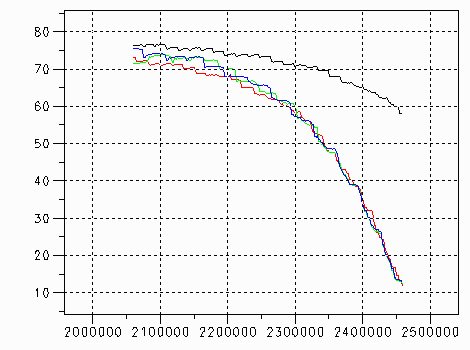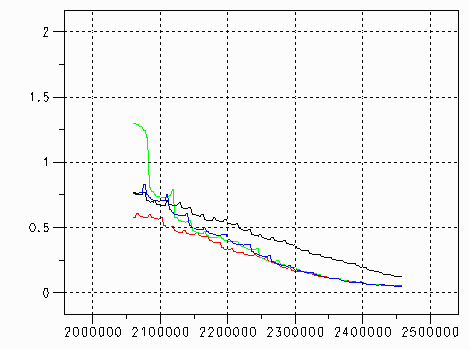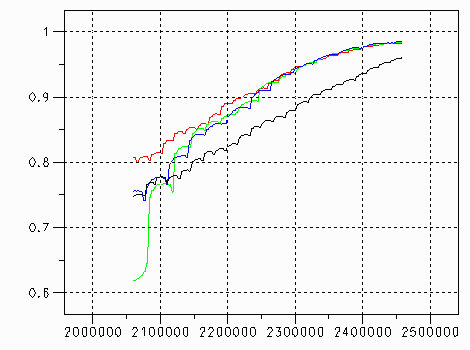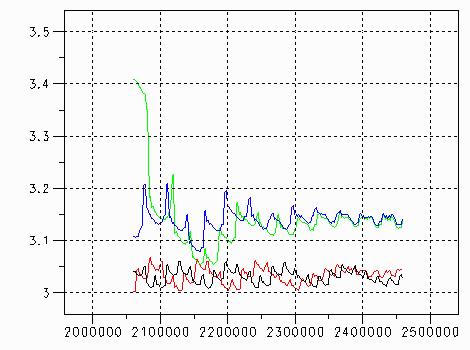
Inclinations (in degree) for the years from 931 to 2020 (click to enlarge)
C/2000 O3 (red), C/2002 Q8 (green), C/2002 S11 (blue), 96P/Machholz (black)
On the Orbital Evolution of the Kracht Group Comets
The identification
C/2002 S11 = C/2008 G6 seems to be wrong,
parts of this page may not be valid
Today (2008 August 04) there a three known
pairs of Kracht group comets which can be described with a common
orbital solution. These are C/2000 O3 = C/2005 W4, C/2002 Q8 =
C/2008 E4, C/2002 S11 = C/2008 G6. This page investigates their
orbital histories and compares them with the orbital history of
96P/Machholz, which is thought to be the source of the Kracht
group comets. The orbital elements for 96P are taken from the JPL
Small-Body Database Browser (reference JPL-49, observations
1986-05-13 to 2007-08-12). The orbital elements of the Kracht
group comets are from the MPECs. All elements were integrated
with SOLEX100 to a common epoch of 2020-12-31 and then backwards
with output every 2000 days until 931-04-20 (200 steps).
For the first about 150000 days (about 410 years) of the backward
integration the evolution of the orbital elements i,q,e of the
three pairs of Kracht group comets is quite similar. Given the
rather short observational arcs of these comets I didn't expect
such a similar evolution over several hundred years. I think that
especially for times before JD 2300000 the results just indicate
what could have happened.

Inclinations (in degree) for the years from 931 to 2020 (click to
enlarge)
C/2000 O3 (red), C/2002 Q8 (green), C/2002 S11 (blue),
96P/Machholz (black)

Perihelion distances (in AU) for the years from 931 to 2020
(click to enlarge)
C/2000 O3 (red), C/2002 Q8 (green), C/2002 S11 (blue),
96P/Machholz (black)

Eccentricities for the years from 931 to 2020 (click to enlarge)
C/2000 O3 (red), C/2002 Q8 (green), C/2002 S11 (blue),
96P/Machholz (black)

Semimajor axis (in AU) for the years from 931 to 2020 (click to
enlarge)
C/2000 O3 (red), C/2002 Q8 (green), C/2002 S11 (blue),
96P/Machholz (black)
I have made a second run of the integrations with output every 100 days to determine when the three pairs evolved through the inclination of the Marsden group. The weighted mean (taking the observed arcs as weights) of the orbital inclinations of the Marsden group comets is about 26.8 degree. The three pairs of Kracht group comets went through this stage in the years 1901 (C/2002 Q8), 1913 (C/2000 O3), 1925 (C/2002 S11).
| Designation | epoch | q | peri | node | incl |
| C/2002 Q8 | 1901-12-02 | 0.0604 | 23.28 | 80.96 | 26.76 |
| C/2000 O3 | 1913-10-20 | 0.0612 | 24.98 | 79.03 | 26.81 |
| C/2002 S11 | 1925-04-20 | 0.0578 | 24.14 | 79.79 | 26.87 |
| mean Marsden | 1996-2008 | 0.0488 | 23.2 | 80.7 | 26.8 |
At first look, the perihelion distances of the
Kracht group comets seem to be a bit too large as compared to the
mean Marsden group. But this could explain why these Kracht group
comets are observed today. With their greater perihelion
distances they could survive the Marsden stage of their
evolution, while the current Marsden group comets are thought to
never arrive at the Kracht group stage.
Rainer Kracht 2008 August 05
I have made another run of the integration with output every 100 days to determine when the three pairs evolved through the weighted mean inclination of all Kracht group comets (1996-2008). The three pairs of Kracht group comets went through this stage in the years 1996 (C/2002 Q8), 2004 (C/2002 S11), 2008 (C/2000 O3).
| Designation | epoch | q | peri | node | incl |
| C/2002 Q8 | 1996-02-07 | 0.0507 | 49.07 | 53.48 | 13.57 |
| C/2002 S11 | 2004-06-04 | 0.0483 | 51.19 | 50.86 | 13.60 |
| C/2000 O3 | 2008-07-13 | 0.0516 | 54.27 | 48.04 | 13.47 |
| mean Kracht | 1996-2008 | 0.0482 | 54.7 | 48.0 | 13.6 |
From mean Marsden to mean Kracht stage they
needed 79 years (C/2002 S11), 94 years (C/2002 Q8), and 95 years
(C/2000 O3).
This compares well with what K.Ohtsuka, S.Nakano and M.Yoshikawa
wrote in PASJ , 55, 321-324, 2003 February 25 about the orbital
evolution of 96P: "In the present study, integrating the
motion of 96P, we found that the orbital elements of 96P at epoch
2319 correspond to those of both the Arietids and the Marsden
comet group, currently observed, and those of 96P at epoch 2408
agree with those of the Kracht comet group, similarly observable
now.". From 2319 to 2408 there are 89 years.
Rainer Kracht 2008 August 06
A fourth pair of Kracht group comets (C/2002 S7 = C/2008 N4) has been announced. Integrating the orbit backwards it takes much more time (199 years) to reach the mean inclination of the Marsden group comets, but again the perihelion distance at this stage is distinctly larger than that of the current Marsden group comets.
| Designation | epoch | q | peri | node | incl |
| C/2002 S7 | 1806-08-22 | 0.0615 | 23.05 | 78.36 | 26.90 |
| C/2002 Q8 | 1901-12-02 | 0.0604 | 23.28 | 80.96 | 26.76 |
| C/2000 O3 | 1913-10-20 | 0.0612 | 24.98 | 79.03 | 26.81 |
| C/2002 S11 | 1925-04-20 | 0.0578 | 24.14 | 79.79 | 26.87 |
| mean Marsden | 1996-2008 | 0.0488 | 23.2 | 80.7 | 26.8 |
| Designation | epoch | q | peri | node | incl |
| C/2002 Q8 | 1996-02-07 | 0.0507 | 49.07 | 53.48 | 13.57 |
| C/2002 S11 | 2004-06-04 | 0.0483 | 51.19 | 50.86 | 13.60 |
| C/2002 S7 | 2005-09-07 | 0.0488 | 52.25 | 50.40 | 13.60 |
| C/2000 O3 | 2008-07-13 | 0.0516 | 54.27 | 48.04 | 13.47 |
| mean Kracht | 1996-2008 | 0.0482 | 54.7 | 48.0 | 13.6 |
Rainer Kracht 2008 August 13
Table of close (<300 Gm, about 2 AU) approaches to Jupiter, minimum distances in Gm, from the times of mean Kracht group inclination backwards to the times of mean Marsden inclination.
| C/2000 O3 | C/2002 Q8 | C/2002 S7 | C/2002 S11 | ||||
| 2008-04-03 | 196.1 | ||||||
| 1996-06-03 | 157.6 | 1996-04-23 | 248.1 | ||||
| 1984-10-04 | 146.6 | 1984-06-11 | 258.9 | 1984-10-03 | 149.0 | ||
| 1972-11-14 | 163.5 | 1972-11-27 | 185.7 | 1972-09-08 | 217.6 | 1972-11-17 | 192.7 |
| 1960-11-06 | 199.8 | 1960-11-03 | 208.0 | 1960-11-20 | 195.7 | 1960-10-26 | 211.7 |
| 1948-11-29 | 132.2 | 1948-11-01 | 148.2 | 1949-01-15 | 191.0 | 1948-10-25 | 154.3 |
| 1937-02-03 | 124.9 | 1937-02-24 | 201.1 | 1937-01-22 | 124.0 | ||
| 1925-05-16 | 186.2 | 1925-08-19 | 284.0 | 1925-03-20 | 229.4 | 1925-07-28 | 268.2 |
| 1913-03-23 | 278.2 | ||||||
| 1866-03-18 | 283.3 | ||||||
| 1854-03-09 | 218.8 | ||||||
| 1842-03.21 | 174.0 | ||||||
| 1830-04-22 | 152.4 | ||||||
| 1818-06-10 | 151.1 | ||||||
| 1806-08-16 | 169.1 |
For C/2002 S7 there are no close approaches <300 Gm between the years 1866 and 1913.
Other close approaches (<15 Gm, about 0.1 AU) between the epoch of the elements and 1960-01-01
| 1995-04-03 | C/2000 O3 - Mercury | 13 Gm |
| 1991-08-17 | C/2002 S11 - Mercury | 15 Gm |
| 1985-05-13 | C/2002 S11 - Venus | 14 Gm |
| 1980-06-28 | C/2002 Q8 - Mercury | 12 Gm |
| 1979-07-06 | C/2002 S7 - Mercury | 11 Gm |
| 1974-12-07 | C/2002 S11 - Mercury | 13 Gm |
| 1969-06-25 | C/2002 Q8 - Mars | 14 Gm |
| 1969-06-07 | C/2002 S11 - Earth | 8 Gm |
| 1969-06-05 | C/2002 Q8 - Earth | 13 Gm |
| 1963-10-26 | C/2002 Q8 - Venus | 8 Gm |
| 1963-10-25 | C/2002 S11 - Venus | 13 Gm |
The pattern of close approaches is remarkably similar for C/2002 Q8 and C/2002 S11: close approaches to Jupiter 1984-10-04 and 1984-10-03, Jupiter 1972-11-27 and 1972-11-17, Earth 1969-06-05 and 1969-06-07, Venus 1963-10-26 and 1963-10-25. The orbits of C/2002 Q8 and C/2002 S11 must have been very similar in the past, especially during the rather close approches to Venus and Earth 1963 and 1969. The perihelion times from the backward integrations are:
| C/2002 Q8 | C/2002 S11 |
| 2002-08-25.9 | 2002-09-30.3 |
| 1997-02-15.3 | 1997-03-16.9 |
| 1991-08-02.1 | 1991-08-25.2 |
| 1986-01-11.5 | 1986-01-27.8 |
| 1980-06-18.7 | 1980-06-30.8 |
| 1974-11-19.3 | 1974-11-26.9 |
| 1969-05-03.0 | 1969-05-05.9 |
| 1963-10-06.5 | 1963-10-04.9 |
Both comets have had the same perihelion time
between the years 1963 and 1969, about 1966. To compare the other
orbital elements (q, e, peri, node, incl), I have computed the
D-criterion for the orbits of the two comets in steps of 40 days
backwards from 2002-09-03 and found a (shallow) minimum of D(M,N)
= 0.0117 for 1972-10-10 (the D(M,N) for 2002-09-03 is 0.0121).
Regarding the uncertainties of the orbits, both results compare
well.
It seems likely that C/2002 Q8 and C/2002 S11 have had very
similar orbital elements at some time between 1966-1972 and that
their common precursor split around that time into C/2002 Q8 and
C/2002 S11.
Rainer Kracht 2008 August 18
New Linkages
Another Kracht group comet was found in 2008
September, C/2008 R7. It was rather bright, even visible in
STEREO SECCHI COR2A images. Possible linkages were with C/2002
S4, S5 and S11. C/2002 S11 was the brightest Kracht comet until
then, but it had been already linked with C/2008 G6.
The identification C/1996 X3 = 2002 S7 = 2008 N4 (2009 May 04,
using nongravitational forces) makes it very probable that C/1996
X4 = 2002 S4 and C/1996 X5 = 2002 S5. If this is true we have
C/2002 S11 = 2008 R7 (the two brightest Kracht comets are two
apparitions of the same comet).
Following these identifications C/2002 S11 = 2008 G6 is wrong.
New computations have shown that most probably C/2002 Q10 = 2008
G6.
The orbital evolution of C/2002 S7 = 2008 N4 doesn't change much by the identification with C/1996 X3 and the inclusion of nongravitational forces. The time from mean Marsden (i=26.8) to mean Kracht (i=13.6) changes from 199 to 191 years. For the new linkage C/2002 Q10 = 2008 G6 we have 91 years, but for C/2002 S11= 2008 R7 the orbital evolution is very slow with 419 years from Marsden to Kracht!
| Designation | epoch | q | peri | node | incl |
| C/2002 S11 | 1589-07-10 | 0.0525 | 23.96 | 74.93 | 26.80 |
| C/2002 S7 | 1806-11-30 | 0.0625 | 22.75 | 78.21 | 26.87 |
| C/2002 Q8 | 1901-12-02 | 0.0604 | 23.28 | 80.96 | 26.76 |
| C/2002 Q10 | 1913-06-02 | 0.0621 | 23.21 | 81.10 | 26.60 |
| C/2000 O3 | 1913-10-20 | 0.0612 | 24.98 | 79.03 | 26.81 |
| mean Marsden | 1996-2008 | 0.0488 | 23.2 | 80.7 | 26.8 |
| Designation | epoch | q | peri | node | incl |
| C/2002 Q8 | 1996-02-07 | 0.0507 | 49.07 | 53.48 | 13.57 |
| C/2002 S7 | 1997-06-21 | 0.0492 | 51.43 | 50.72 | 13.59 |
| C/2002 Q10 | 2004-08-03 | 0.0485 | 51.46 | 50.70 | 13.60 |
| C/2002 S11 | 2008-06-03 | 0.0478 | 52.74 | 49.70 | 13.60 |
| C/2000 O3 | 2008-07-13 | 0.0516 | 54.27 | 48.04 | 13.47 |
| mean Kracht | 1996-2008 | 0.0482 | 54.7 | 48.0 | 13.6 |
Rainer Kracht 2009 May 22